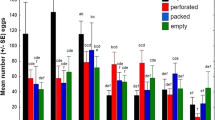Abstract
From 2008 to 2014, stored product mites have been reported from prepackaged dried food on the market in the Czech Republic. The infestation was by Carpoglyphus lactis (L.) in dried fruits and Tyrophagus putrescentiae (Schrank) in dog feed. The infestation is presumably caused by poor protection of the packages. We compared various packaging methods for their resistance to mites using dried apricots and dog feed in laboratory experiments. The trial packages included nine different plastic films, monofilm, duplex and triplex, and one type of plastic cup (ten replicates per packaging type). All packaging materials are available on the Czech market for dried food products. The samples of dried food were professionally packed in a factory and packaged dried apricots were exposed to C. lactis and dog food to T. putrescentiae. After 3 months of exposure, the infestation and mite density of the prepackaged food was assessed. Mites were found to infest six types of packages. Of the packaging types with mites, 1–5 samples were infested and the maximum abundance was 1,900 mites g−1 of dried food. Mites entered the prepackaged food by faulty sealing. Inadequate sealing is suggested to be the major cause of the emerged infestation of dried food.

Similar content being viewed by others
References
Athanassiou CG, Riudavets J, Kavallieratos NG (2011) Preventing stored-product infestation in packaged-food products. Stewart Postharvest Rev 3:1–5
Brazis P, Serra M, Sellés A, Dethioux F, Biourge V, Puigdemont A (2008) Evaluation of storage mite contamination of commercial dry dog food. Vet Dermatol 19(4):209–214
Canfield MS, Wrenn WJ (2010) Tyrophagus putrescentiae mites grown in dog food cultures and the effect mould growth has on mite survival and reproduction. Vet Dermatol 21:58–63
Cobanoglu S (2009) Mite population density analysis of stored dried apricots in Turkey. Int J Acarol 35:67–75
Gill C, McEwan N, McGarry J, Nuttall T (2011) House dust and storage mite contamination of dry dog food stored in open bags and sealed boxes in 10 domestic households. Vet Dermatol 22(2):162–172
Highland HA (1978) Insect resistance of food packages—a review. J Food Proc Preserv 2:123–130
Hou X, Fields P, Taylor W (2004) The effect of repellents on penetration into packaging by stored-product insects. J Stored Prod Res 40:47–54
Hubert J, Erban T, Nesvorna M, Stejskal V (2011) Emerging risk of infestation and contamination of dried fruits by mites in the Czech Republic. Food Add Contam (A) Chem Anal Cont Exp Risk Asses 28(9):1129–1135
Hubert J, Nesvorná M, Kopecký J (2014) The effect of Tyrophagus putrescentiae on Fusarium poae transmission and fungal community in stored barley in a laboratory experiment. Insect Sci 21:65–73
Hughes AM (1976) The mites of stored food and houses. Tech. Bull. No. 9. Ministry of Agriculture Food and Fisheries, London, pp 400
Mueller RS, Fieseler KV, Rosychuk RA, Greenwalt T (2005) Intradermal testing with the storage mite Tyrophagus putrescentiae in normal dogs and dogs with atopic dermatitis in Colorado. Vet Dermatol 16:27–31
Mullen MA (1994) Rapid determination of the effectiveness of insect resistant packaging. J Stored Prod Res 30:95–97
Newton J (1988) Insect and packaging—a review. Int Biodeterior 24:175–187
Phillips TW, Throne JE (2010) Biorational approaches to managing stored product insects. Ann Rev Entomol 55:375–397
Riudavets J, Salas I, Pons MJ (2007) Damage characteristics produced by insect pest in packaging film. J Stored Prod Res 43:564–570
Rodriguez del Rio P, Tudela Garcia JI, Narganes NJ, Fernández-Caldas E, Rodríguez-Garcia V, Subiza J (2012) Occupational asthma caused by the inhalation of Tyrophagus putrescentiae allergens in a dry-cured ham transporter allergic to shrimp. J Investig Allergol Clin Immunol 22(5):383–384
Thind BB, Clarke PG (2001) The occurrence of mites in cereal-based foods destined for human consumption and possible consequences of infestation. Exp Appl Acarol 25(3):203–215
Zheltikova TM, Gervazieva VB, Zhirova SN, Mokronosova MA, Sveranovskaia VV (1997) Storage mites as the source of household allergens. Zh Mikrobiol Epidemiol Immunobiol 6:73–76 Article in Russian
Acknowledgments
The authors thank the anonymous referee and Marketa Mareckova for valuable comments on the manuscript. The films were given by companies CHEMOSVIT FOLIE Slovakia and AL INVEST division TAPA Tábor CZ, the cups by JOKEY Praha CZ, as free samples for experiments. The vertical FFS packaging machine was provided by ASTRO Vlašim CZ without charge. The authors are obligated to all mentioned companies. JH and MN were supported by project RO0414 of the Czech Ministry of Agriculture.
Author information
Authors and Affiliations
Corresponding author
Rights and permissions
About this article
Cite this article
Hubert, J., Nesvorna, M. & Volek, V. Stored product mites (Acari: Astigmata) infesting food in various types of packaging. Exp Appl Acarol 65, 237–242 (2015). https://doi.org/10.1007/s10493-014-9864-1
Received:
Accepted:
Published:
Issue Date:
DOI: https://doi.org/10.1007/s10493-014-9864-1




